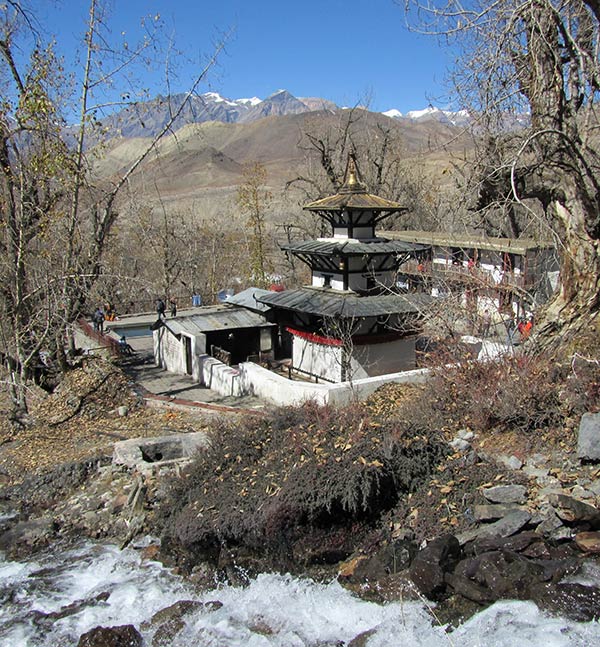
Arranged at a height of 3,710 meters (12,172 feet) at the base of the Thorong La mountain go in the Mustang region, Muktinath is a very adored sacrosanct place for both Hindus and Buddhists.
Hindus call the site Mukti Kshetra, which truly implies the "place of salvation" and it sites.is a standout amongst the most antiquated sanctuaries of the God Vishnu and the Vaishnava convention in Nepal. The altar is thought to be one of the eight sacrosanct spots known as Svayam Vyakta Ksetras (the other seven being Srirangam, Srimushnam, Tirupati, Naimisharanya, Totadri, Pushkar and Badrinath), and in addition one of the 108 Divya Desam, or heavenly spots of love of Lord Vishnu. Furthermore, it is likewise one of the 51 Shakti Pitha goddess
The sanctuary is little and contains a human-sized brilliant statue of Vishnu as Shri Mukti Narayana. Notwithstanding Mukti Narayana, the sanctuary has bronze pictures of Bhoodevi (the Earth-goddess type of Lakshmi), the goddesses Saraswati and Janaki (Sita), Garuda (the mount of Vishnu), Lava-Kusa (the children of Rama and Sita) and the Sapta Rishis (Seven Sages made by Lord Brahma). There is an old Buddhist minister introduce in the sanctuary and love is directed by Buddhist nuns.Behind the sanctuary is a semi-round divider with 108 stone spigots at a tallness of seven feet. The spigots all have a similar state of the leader of a bull and are isolated by roughly one foot. Water from the super cold Kali Gantaki River has been occupied to course through the mouths of these bulls and tough travelers who visit the sanctuary frequently remain underneath each of the spouts.
The number 108 conveys awesome centrality in Eastern rationality. In Hindu crystal gazing, there are 12 zodiac or Rashi and 9 planets or Graha, giving a sum of 108 blends. Additionally there are 27 Lunar chateaus or Nakshatras, which are isolated in 4 quarters, or Padas each giving a blend of 108 Padas altogether.
The Kali Gantaki riverbed downstream from Muktinath is the sole wellspring of the uncommon Shaligram stones that are required to build up a sanctuary of Vishnu anyplace in the world.Buddhists call Muktinath Chumming Gyatsa, which in Tibetan signifies 'Hundred Waters'. As per Tibetan Buddhism Chumig Gyatsa is a hallowed place of the Dakinis goddesses known as Sky Dancers, and furthermore one of the 24 observed Tantric spots. Also, the site is accepted to be an appearance of Avalokitesvara, the Bodhisattva of Compassion and Virtue. The Tibetan Buddhist custom expresses that Guru Rimpoche, otherwise called Padmasambhava, the originator of Tibetan Buddhism, reflected here on his approach to Tibet.
In the wake of finishing supplications and love at the Muktinath sanctuary numerous explorers, both Hindu and Buddhist, visit Mebar Lha Gomba, the little cloister of `miraculous fire', which is arranged close to the passage door of the sanctuary. This cloister, committed to Guru Rimpoche (Padmasambhava) and containing a statue of the Buddhist god Chenrezig (Avalokitesvara), is acclaimed for its ceaselessly consuming petroleum gas fire, which Hindus love as Jwala Mai, the Goddess of Fire.
No comments:
Post a Comment